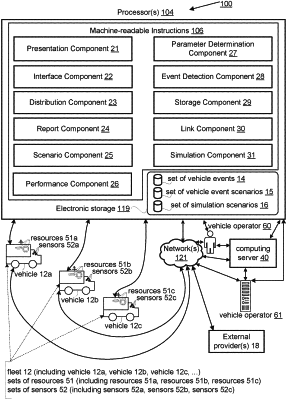| CPC G09B 9/052 (2013.01) [B60W 40/09 (2013.01); B60W 50/14 (2013.01); G08G 1/167 (2013.01)] | 16 Claims |

|
1. A system configured to determine driving performance by a vehicle operator and by a second vehicle operator for simulated driving of a simulated vehicle in a simulation engine, wherein the vehicle operator and the second vehicle operator are included in a set of vehicle operators, wherein the simulated driving is based on real-world operation of real-world vehicles, the system comprising:
electronic storage configured to electronically store information; and
one or more processors configured via machine-readable instructions to:
determine one or more vehicle parameters of individual vehicles, wherein the one or more vehicle parameters are determined directly based on output signals from at least two different sensors, wherein the one or more vehicle parameters are determined multiple times in an ongoing manner during operation of the vehicle;
obtain a stored set of vehicle event scenarios that correspond to vehicle events that have occurred in the real world at particular times during the real-world operation of the real-world vehicles, wherein individual vehicle events are associated with physical surroundings of individual vehicles around the particular times the individual vehicle events occurred, wherein individual vehicle events are detected based on comparing the one or more vehicle parameters of individual vehicles with one or more thresholds, wherein a first vehicle event scenario is associated with a first set of circumstances that is based on a first set of physical surroundings of a first vehicle around a particular time a first vehicle event occurred, wherein the first vehicle event scenario has a scenario time period that begins prior to an occurrence of a potential vehicle event;
create a set of simulation scenarios that are suitable for use by the simulation engine, wherein individual ones of the set of simulation scenarios correspond to individual ones of the stored set of vehicle event scenarios, wherein individual ones of the set of simulation scenarios mimic circumstances associated with a corresponding vehicle event scenario, such that a first simulation scenario mimics the first set of circumstances associated with the first vehicle event scenario, wherein the simulated vehicle is based on the first vehicle;
establish a communication link between the vehicle operator and the simulation engine, wherein the vehicle operator is an autonomous driving algorithm that controls operations of the simulated vehicle autonomously through the communication link;
run the set of simulation scenarios in the simulation engine, wherein the simulated vehicle interacts with the vehicle operator and is operated by the vehicle operator based on input received from the autonomous driving algorithm;
detect, by the simulation engine during the running of the set of simulation scenarios, one or more simulated vehicle events that have occurred to the simulated vehicle as the autonomous driving algorithm controlled the operations of the simulated vehicle;
determine one or more metrics that quantify a performance of the vehicle operator in running the set of simulation scenarios, wherein the determination of the one or more metrics is based on the one or more simulated vehicle events as detected;
establish a second communication link between the second vehicle operator and the simulation engine, wherein the second vehicle operator is a second autonomous driving algorithm that controls operations of the simulated vehicle autonomously through the second communication link;
run the set of simulation scenarios in the simulation engine, wherein the simulated vehicle interacts with the second vehicle operator and is operated by the second vehicle operator based on second input received from the second autonomous driving algorithm;
detect, by the simulation engine during the running of the set of simulation scenarios, a second set of simulated vehicle events that have occurred to the simulated vehicle as the second autonomous driving algorithm controlled the operations of the simulated vehicle;
determine a second set of metrics that quantify a second performance of the second vehicle operator running the set of simulation scenarios, wherein the determination of the second set of metrics is based on the second set of simulated vehicle events as detected;
compare the performance of the vehicle operator with the second performance of the second vehicle operator, wherein comparison is based on the one or more metrics and the second set of metrics;
based on the comparison, determine whether the vehicle operator or the second vehicle operator performed best in running the set of simulation scenarios; and
generate a report based on the comparison and transfer the report to one or more users.
|